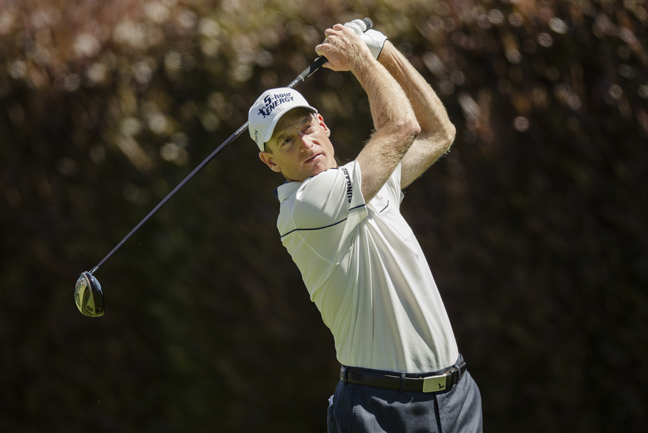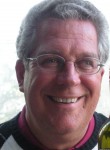
SAN FRANCISCO – A small bucket from the first three days of the 112th U.S. Open at The Olympic Club, as the legend of Beau Hossler continues to grow:

• It was Jim Furyk and Graeme McDowell, both former U.S. Open champions, who emerged as the third-round co-leaders at 1-under par on a balmy Saturday in the Bay Area, while Tiger Woods struggled to a 75 and fell from the top of the leaderboard into a tie for 14th.
But it was Hossler, the 17-year-old amateur from Mission Viejo, who won over the huge galleries with an even-par 70 that left him tied for eighth at 3-over par.
As he walked up the 18th fairway, Hossler doffed his visor to acknowledge a standing ovation from an estimated 10,000 fans in the bleachers and around the green. And he got another rousing ovation after tapping in for par.
“That was incredible!” Beau said afterward. “I haven’t had anything like that before. I appreciate the support from everybody out there. It’s really special.”
• Call him “Bounce Back Beau.” Each of the four times he made a bogey Saturday, he rebounded with a birdie on the next hole. He bogeyed No. 3 and birdied No. 4; he bogeyed No. 6 and birdied No. 7; he bogeyed No. 11 and birdied No. 12; and he bogeyed No. 13 and birdied No. 14.
“You can’t over-emphasize how key that is; I was fortunate to go out and get some (shots) back,” he said. “The bogey train can kill you.”
• Hossler’s goal going into the week was to win low amateur honors, meaning he would have to finish ahead of UCLA star Patrick Cantlay and future University of Texas teammate Jordan Spieth, two of the world’s top amateur.
So far, so good. Spieth is at 7-over and Cantlay at 9-over through 54 holes.
Suddenly, however, it has dawned on Hossler that a more ambitious challenge is within reach.
“It (low amateur) is still my goal, but I feel like I’m in contention to win the tournament,” he said.
Can he win the U.S. Open?
“Absolutely,” said Hossler, who finished his junior year at Santa Margarita High last week. “There’s not a doubt in my mind.”
• In case you’re wondering, the last amateur to win the U.S. Open was Johnny Goodman in 1933.
Jack Nicklaus finished second as an amateur in 1960 and tied for fourth in 1961. Ken Venturi finished eighth as an amateur in 1956.
Since Nicklaus’ near-misses, only two amateurs have finished in the top 10: Johnny Miller (T8 in 1966) and Jim Simons (T5 in 1971).
Hossler is the first amateur in the top 10 after 54 holes since Matt Kuchar in 1998.
• Here’s how close Hossler came to being near the lead going into the final round instead of four shots back. He uncharacteristically 3-putted from 6 feet for a bogey on No. 11 and lipped out a 10-foot birdie putt on No. 15 and a 3-foot birdie putt on No. 17.
• Though he had four birdies, Hossler thought his par on No. 9 and his bogey on No. 13 kept his round together.
On the ninth, he pulled his tee shot deep into the trees bordering the left side of the fairway, pitched out to the fairway through a narrow opening in the treeline and got up and down from 150 yards for par.
On the par-3 13th, his second-shot chip from below the green rolled back to his feet, and he putted up the steep slope with his third shot and tapped in for bogey.
• With the world’s top three players playing together in the first two rounds, it had to be embarrassing to No. 1 Luke Donald (11-over) and No. 2 Rory McIlroy (10-over) the defending U.S. Open champion, to see such high scoring totals next to their names on the signs carried by the standard bearers from hole to hole.
Both missed the cut. At least No. 3 Lee Westwood (2-over through 54 holes) is still in the hunt.
• Donald blamed poor putting during his opening-round 79 for his missing the cut.
“I think I missed nine putts inside 10 feet (Thursday) and just couldn’t get the feel for the greens; the reads, the speed,” he said.
• McIlroy, on missing the cut: “I’m obviously disappointed. It wasn’t the way I wanted to play . . . and to be honest, overall I don’t think I played that badly for the last two days. It’s just such a demanding golf course and just punishes the slightest shot that’s offline or that’s maybe the not the right distance. You just have to be so precise out there.”
For what it’s worth, McIlroy hit 62 of 72 greens-in-regulation during his Open romp at Congressional in 2011; this year, he hit only 19 of 36 GIR.
• Nick Watney, who thrilled the gallery with a double-eagle 2 on the 512-yard par-5 17th hole on Thursday, gave those three strokes back on the first two holes Friday with a bogey on No. 1 and a double-bogey on No. 2.
Asked the biggest difference between his 69 on Thursday and his 75 on Friday, Watney quipped, “I didn’’t make an albatross today.”
Watney holed his second shot with a 5 iron from about 200 yards.
On Saturday, John Peterson aced the par-3 13th. But I’m more impressed by double-eagles.
• Here’s an indication of how difficult Olympic Club’s Lakes Course is playing: Scoring average for the field through two rounds was 74.5, or 4 ½ strokes over par.
Four of the first five par-4s averaged from 4.45 to 4.55. Even the par-5 16th averaged 5.42, which is rare for a par-5. Of course, 670-yard par-5s are about as rare as a double-eagle.
• Here’s another way to sum up the first six holes, arguably the most challenging opening stretch in Open history: When Woods and Furyk, Saturday’s final twosome, finished those six, the entire field was 951-over par on those holes through three rounds. That stat was courtesy of ESPN Radio.
• Despite his well-chronicled problems off the course, a number of head-turning women were following Tiger’s group the first two days. Overheard three women giggling about his physique. Some things never change.
• As usual, a number of tour pros were grumbling about the difficulty and set-up at Olympic, but Padraig Harrington was not one of them.
“The course is super. Very beautiful,” Harrington said. “Nice set-up, too. But firm greens scare the life out of (some) professional golfers.”
• The course set-up for the third round was very interesting, with a 256-yard par-3 (No. 3) and 268-yard par-4 (No. 7). It also featured back-to-back holes representing both ends of the distance spectrum: a 107-yard par-3 (No. 15) followed by a 671-yard par-5 (No. 16).
On Saturday, No. 3 became the second-longest par-3 in Open history and No. 16 became the longest par-5 in Open history.
• Spotted in different parts of the gallery over the weekend: Fred Couples, Natalie Gulbis, 49ers quarterback Alex Smith and Green Bay Packers quarterback Aaron Rodgers, a former Cal star.
When one fan yelled that he wished the 49ers had drafted him, Rodgers retorted, “Glad they didn’t.”
• Olympic’s famed “burger dogs” were a big hit at the concession stands. They’re hamburgers shaped liked frankfurters and served on hotdog buns. I keep testing them every day to make sure the quality remains constant.
